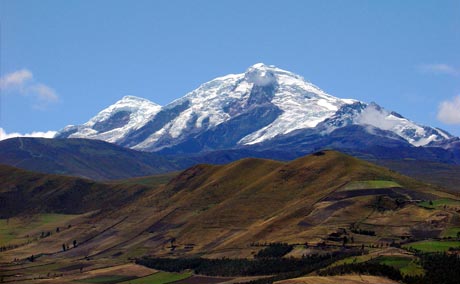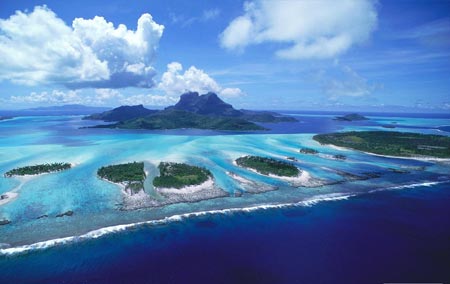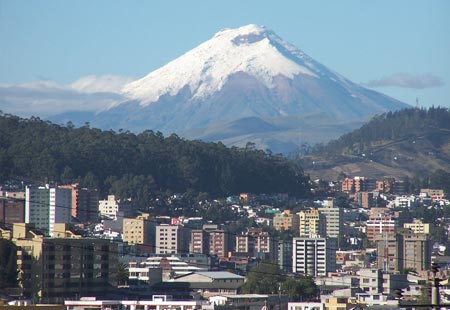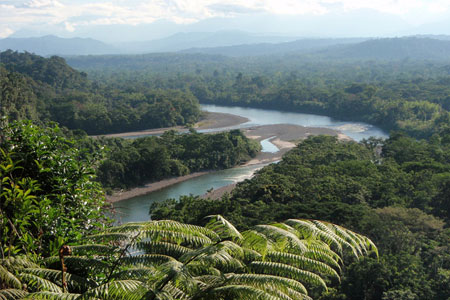Ecuador
Country statistics

Land area: 106,888 sq miles (276,840 sq km)
Total area: 109, 483 sq miles (283,560 sq km)
Population (2011 est.): 15,007,343 (growth rate: 1.4%); birth rate: 19.9/1000; infant mortality rate: 19.6/1000; life expectancy: 75.7; density per sq km: 50
Capital City: Quito
Monetary unit: U.S. dollar
Languages: Spanish (official), Quechua, other Amerindian languages
Ethnicity/race: mestizo (mixed Amerindian and white) 65%, Amerindian 25%, Spanish and others 7%, black 3%
Religions: Roman Catholic 95%
Country introduction

Ecuador is bordered by Colombia on the north, Peru on the east and south, and by the Pacific Ocean to the west. The country also includes the Galápagos Islands in the Pacific, about 1,000 km (620 miles) west of the mainland.
Ecuador is geographically divided into four regions, the western coastal lowlands, the Central Andean highlands, the eastern jungles of the Amazon basin and the Galápagos Islands west off the mainland.
Ecuador's western lowlands is made up of fertile plains, rolling hills, and sedimentary basins that are transported by the many rivers rushing from the heights of the Andes to the Pacific Ocean. The western lowlands was once thick with forests, but today it is blanketed by coffee plantations, banana, palm and cacao farms. It is estimated that 98% of the native forest of coastal Ecuador had been eliminated in favor of cattle ranching and other agricultural productions. A few protected pockets, such as the Maquipucuna biological reserve still provide some glimpses of Ecuador's once spectacular forestlands. The 640 km (397 miles) of coastline also has many attractive beaches and plenty of hotels and resorts for tourists. Crisscrossed by an expansive network of rivers and home to the nation's most spectacular beaches, the provinces of Esmeraldas, Manabí, and Guayas offer impressive destinations for tourists to visit.
The Andean highlands crosses the country from north to south and are composed of two volcanic ranges separated by a central valley in which the bulk of the population lives. The highlands also contain the nation's highest mountain, Chimborazo, whose 6,268 m (20,564 ft) peak makes its summit the farthest point on the Earth's surface from the Earth's center due to the equatorial bulge. Close to Quito, Mt. Cotopaxi is the tallest active volcano in the world at 5,897 m (19,347 ft). Colonial cities, small Andean villages and dozens of Indian Markets give this region its unique cultural heritage.
The Amazon basin lowlands east of the Andes are an almost impenetrable tangle of rainforest known to Ecuadorians as the Oriente (the East). Although the Amazon itself does not flow through Ecuador, all rivers east of the Andes eventually empty into it. The rainforest is still largely untouched, although oil exploitation has taken a big toll in some areas. A number of small communities of native nomad tribes still roam in the jungle. The most impressive elevated regions are in the north and include Volcano Sumaco. The Lowlands, found further to the east, are home to some of the nation's most beautiful and important rivers, the Putumayo, the Napo, and the Pastaza.
The world famous Galápagos Islands were Ecuador's first national park and are celebrated for their unique and fearless wildlife. It was Charles Darwin's September 1835 exploration of the Galapagos, while serving as a naturalist on the British ship HMS Beagle, and his subsequent 1859 publication "On the Origin of Species by Natural Selection" that first brought the world's attention to the islands. Today, the Galapagos remain a living laboratory of evolution where animals have no fear of man. These incredible islands harbor the rarest species known. The region consists of 13 major islands and dozens of smaller islets and rocks, all created by the result of volcanic activity.
The culture

The Afro-Ecuadorians that are present in Ecuador today are famous for their marimba music and many music and dance festivals. Long before the Spanish conquered Ecuador and even before the rise of Incan civilization, the diverse native cultures of the region had rich musical traditions. Music played an important role in the ancient Andean people's lives and archaeologists have found some very old instruments, such as, drums, flutes, trumpets and other musical artifacts, in ancient tombs.
With such a cultural mix there are many interesting handicrafts to be found. Ecuador is the true home of the 'Panama' straw hat. The Otavaleños Indians and their markets are undoubtedly one of the most important and spectacular in all of Latin America. They are particularly world famous for their traditional weaving techniques, which has made them the most prosperous indigenous group in Ecuador. In the markets, items such as woven bags, wood-carvings, bread figures, primitive paintings and silver jewellery can be purchased.
The Ecuadorians have a distinctive type of dress code. The men and especially the woman in each region of Ecuador and the Galápagos Islands can be easily identified by their dress as it displays specific cultural diversities that are characteristic of that particular region.
Ecuador has some very tasty and very strange combinations in their cuisine. It can be expected to find some lemon marinated shrimps, toasted corn on the cob and a huge variety of pastries filled with all types of different stuffing.
Fiestas are an important part of Ecuadorian life and there are many local festivals throughout the country. Some big festivals include the Holy Week, Corpus Cristi, Day of the Dead, Christmas and New Year. Christmas in particular is celebrated in a grand way in Ecuador and to enjoy the best and most original Christmas celebration, visitors should go to Cuenca on the 24th of December where the Pase Del Nino is held. Carnivals in Ecuador is a fun day and usually involve soaking each other with water, except in Ambato where a more genteel fruit and flower festival takes place.
Attractions & landmarks

Being the capital, Quito is one of the most visited cities in the country of Ecuador. The city has many historical monuments, various museums, different natural tourist hot spots, and various churches that are famous for its architectural designs. While there, a visit to El Panecillo is highly recommended as it will reward visitors with a fabulous vantage point from which to appreciate the beauty of the Andean area and the urban fabric of the city. Also, the 200 m (656 ft) high hill has a giant aluminum sculpture of the Virgin of Quito perched atop. Even more amazing views can be enjoyed from the Teleférico (cable cars) that reaches up to 4,100 m (13,451 ft) high. It will give visitors a spectacular view of the city and its surroundings, including more than 14 peaks of the Andes called the Volcanoes Avenue. It also has different services that include an amusement park, shopping center, food court, exclusive restaurants, handicraft stores, go kart track, coffee shops, horseback riding and a nightclub.
South of Quito is a long valley to Cuenca, which is divided by two mountain ranges. These mountains contain some of Ecuadors most magnificent scenery and 9 of its 10 highest peaks. A visit here will also lead to the discovery of isolated Indian villages with people living traditional lifestyles. These are located in Saquisilí, Pujillí, Zumbagua, Sigchos and San Miguel de Salcedo.
A visit to the town of Otavalo should not be missed either, as this area is well known for their traditional Indian marketplace, which is the largest indigenous market in the world. All kinds of handicrafts can be purchased here, ranging from alpaca sweaters, scarfs, shawls, tapestries, rugs, toys and slippers to ceramic chess sets, ivory ornaments and silver jewellery. Besides visiting Otavalo, it is also worth visiting the world famous leather handicraft village of Cotacachi, the wood handicrafts village of San Antonio de Ibarra, and to the beautiful Cuicocha Lake.

Located in the lowlands of the Amazon Basin, the jungle region contains huge areas of primary rainforest. From remote lodges tucked away in the jungle, visitors can set out on the rivers and trails snaking through the undergrowth in search of monkeys, sloths, toucans, river dolphins, anacondas and other creatures. Some lodges also have canopy towers offering magnificent views and a better chance to see birdlife. The main towns in this region are Puyo, Tena, Coca, Lago Agrio, and Macas which is in the south.
West of continental Ecuador, 1,000 km (620 miles) off the mainland are a group of volcanic islands called the Galápagos Island. The islands are abundant with wildlife and will provide visitors with the opportunity to get close to massive lumbering tortoises, swim with sea lions, witness a blue-footed booby doing their famous mating dance, watch the flight of a waved albatross and to relax with the inspiring pristine nature.